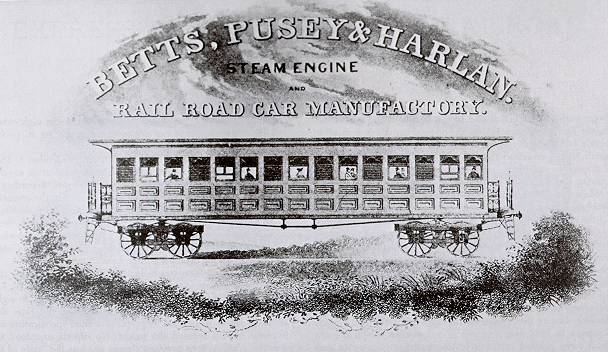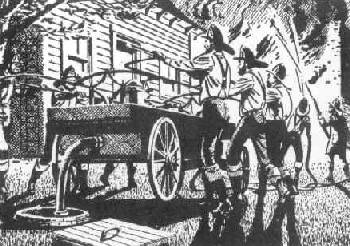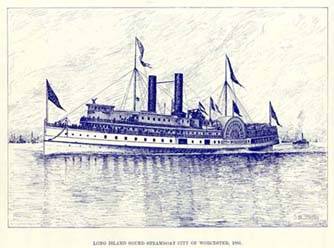Harlan & HollingsworthBetts, Pusey & Harlan
|
 |
|
Cover of 1839 prospectus promoting 8-wheeled cars for export. |
In 1840, Betts, Pusey & Harlan employed a former house carpenter named Jacob F. Sharp as a car builder. Sharp eventually became foreman of the shop, and his experience as a car builder was doubtlessly a key element in the success of the firm he founded at Wilmington in 1863: Jackson & Sharp.
About the same time, Betts, Pusey & Harlan expanded onto adjacent land along the Christina River, and started building and repairing wooden ships: a not uncommon sideline for early builders of wooden railway cars.
In 1841, Elijah Hollingsworth, Samuel Harlan’s brother-in-law, purchased Samuel Pusey’s interest in the company, and they began to do business as Betts, Harlan & Hollingsworth.
--- Betts, Harlan & Hollingsworth ---
During the period 1840-45, Betts, Harlan & Hollingsworth built a number of hand engines for fire fighting. These “engines” consisted of a rectangular wooden box mounted on four low wheels. Piston type pumps were firmly fixed to the floor of the box, working levers were provided, and motion was imparted by the up-and-down pumping of many men. In the early years these “hand tubs” had to be filled by bucket brigades, but in later years, companies such as Betts, Harlan & Hollingsworth built them with suction pumps capable of lifting water from cisterns.
 |
Sketch of a typical “handtub” in action, drawing water from a cistern. We have no idea at this time just what Harlan & Hollingsworth’s particular hand engines looked like. |
In 1841 Betts, Harlan & Hollingsworth became the first of the numerous Wilmington shipbuilders to erect iron ships. It would be another four years before experimenters even began to think of iron railway cars, and 50 years or more before they became accepted.
In 1844 Betts, Harlan & Hollingsworth launched the Bangor, the first propeller-driven iron-hull steamer. It is unclear to us whether they also built the first twin-screw, oceangoing iron-hull steamer in 1845 or whether this was the same ship. For a dozen years after this, Wilmington produced more iron tonnage in shipbuilding than any other U.S. city.
Apparently Mahlon Betts withdrew from the firm sometime before 1850, as Thomson's Mercantile and Professional Directory for Delaware, 1851-1852, lists simply Harlan & Hollingsworth, engine builders and machinists, Wilmington.
--- Harlan & Hollingsworth ---
From 1856 to 1860 Harlan & Hollingsworth constructed four steamships for Charles Morgan’s Southern Steamship Co. Each included a single vertical walking beam engine and a compartmentalized hull. Morgan was so pleased with Harlan & Hollingsworth’s work that over the years he bought a total of 28 ships from them.
In 1858, J. Taylor Gause, who had started with the firm as a clerk some 15 years earlier, was admitted as an equal partner in the firm, which became Harlan, Hollingsworth & Co.
--- Harlan, Hollingsworth & Co. ---
There may have been little interest in this country in iron railroad cars, but by the 1860s there was substantial interest overseas. Harlan, Hollingsworth & Co. was among those trying to capitalize on this market, and they built several iron freight cars for the Reading and for the Panama Railroads. But except for an occasional car, it would be years before this became a substantial market.
On the other hand, by the time of the Civil War, Harlan, Hollingsworth & Co. was the “preeminent shipbuilder” in a city that was a leader in the manufacture of iron vessels.
 |
Steamship “City of Worchester” built by Harlan & Hollingsworth, 1881. |
During the Civil War, Harlan, Hollingsworth & Co. constructed a number of ironclad monitors for the U.S. Navy. Best known was the monitor Saugus, launched 16 December 1863. The Saugus was assigned to the North Atlantic Blockading Squadron at Fortress Monroe to protect army transports heading up the James River in an attack on Richmond. Two alleged accomplices to assassin John Wilkes Booth were briefly imprisoned aboard during April 1865 to prevent the mobs from meting out their own justice.
Also during 1863, Jacob Sharp left the firm to go into business for himself with Job Jackson. Jackson & Sharp became the second of what would eventually be three car builders at Wilmington.